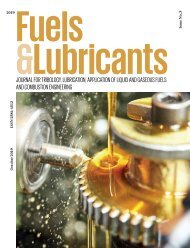Fuels & Lubricants Magazine
Issue No. 2, June 2018
Issue No. 2, June 2018
You also want an ePaper? Increase the reach of your titles
YUMPU automatically turns print PDFs into web optimized ePapers that Google loves.
GREEN CORNER<br />
biomass into bio pyro oil, and gas and char as side-products.<br />
Capacity is 24 kt/y by BTG’s rotating cone technology.<br />
14 The stream is used for electric power generation<br />
in nearby industry. Bio pyro oil is co-feeds boiler system<br />
for heating of Friesland Campina Company with natural<br />
gas.<br />
Ensyn, Canada has operated over 25 years, and with<br />
Rapid Thermal Technology processes over 21 kt/y from<br />
wood residues. 17 Production focus is on fuels for heating<br />
and cooling purposes, and on refinery feedstock to<br />
produce renewable ‘drop-in’ gasoline and diesel, and as<br />
a chemical feedstock to produce food flavourings and<br />
fragrances. To date, Ensyn has designed and built seven<br />
commercial RTP plants in the United States and Canada<br />
for use in the manufacture of more than 30 commercial<br />
products ranging from food flavourings to adhesive resins<br />
for construction. 18<br />
Valmet developed technology for bio pyro oil production<br />
in riser reactor and delivered hundreds of fluidized<br />
bed boilers worldwide, with the intention to expand biooil<br />
production with integrated pyrolysis technology. 15<br />
Co-processing provides<br />
production of products<br />
related to standard<br />
specifications for<br />
transportation fuels and<br />
therefore does not require<br />
segregated handling and<br />
distribution downstream of<br />
the refinery.<br />
Challenges in Co-processing<br />
The principle of co-processing is adding of bio-crude in<br />
some part of refinery streams with minimal unit modifications<br />
and process conditions changes. Co-processing<br />
provides production of products related to standard<br />
specifications for transportation fuels and therefore does<br />
not require segregated handling and distribution downstream<br />
of the refinery, as is the case with some other<br />
renewables, as ethanol and biodiesel. 19<br />
A lot of challenges of co-processing in different units<br />
is present in combination with refinery streams and in<br />
laboratory analytics. Some of them are further: possible<br />
incompatibility with refinery feedstock, the effect<br />
of water forming on process parameters, catalyst and<br />
products, changes in kinetics and conversion, including<br />
influence on material balance and product distribution,<br />
yield and quality.<br />
Bio pyrolysis oil is not possible to use directly as blending<br />
component in transport fuels without upgrading<br />
process. 20 The first choice of bio pyro oil co-processing<br />
is FCC unit. The bio pyro oil changes a part of standard<br />
FCC feedstock, vacuum gas oil (VGO). From literature<br />
is unknown the exact amount of added bio pyro oil for<br />
co-feeding, but more than 5 % is not recommended in<br />
this phase, due to nature of bio pyro oil and insufficient<br />
readiness of technology. 14 The pyrolysis oil complexity<br />
and very different properties from petroleum feedstock<br />
and products are the main problems in co-processing.<br />
In FCC co-processing the main challenges are connected<br />
with unknown bio pyro influence on process<br />
parameters, catalyst activity and product distribution<br />
and quality. The usual FCC reactions take place during<br />
biomass conversion. Detail mechanism is described in<br />
2, 11<br />
literature.<br />
Some companies have conducted trials and demonstration<br />
of FCC co-processing in different scale including<br />
commercial unit. Petrobras published articles about<br />
carried out of testing in FCC demonstration-scale unit.<br />
The different yield distribution is obtained by adding a<br />
different amount of bio pyro oil. A general conclusion is<br />
that coke and gas yield increased, while gasoline and light<br />
cycle oil varies depends on the added amount of bio pyro<br />
oil. The most oxygen was removed as water, CO and<br />
CO 2<br />
during cracking process. Some amount remained in<br />
liquid products as alkyl phenols in co-processed gasoline<br />
and diesel products. The produced light cyclic oil was<br />
tested and found suitable for hydrogenation as diesel<br />
blendstock, while gasoline hydrogenation tests were also<br />
1, 11, 21<br />
being conducted.<br />
Due to the high acidity, it is necessary to take care of<br />
bio pyro oil storage and feed line material. Stainless steel<br />
is recommended. Furthermore, bio pyro oil is not miscible<br />
with FCC feed and request separate entrance into<br />
the reactor. The plugging of feed nozzle or feed line was<br />
noticed in some literature. 22<br />
Catalyst activity can drop if bio feed contents higher<br />
amount of alkali and earth alkali metals.<br />
Testing results of some laboratory small scale FCC<br />
units suggest that feed behaviour in small scale is different<br />
from larger or commercial scale units, especially in<br />
coke formation. There are more complicated to predict<br />
the behaviour of bio pyro in FCC commercial units and<br />
their influence on full system and products. 1<br />
It is very important to know how the renewable carbon<br />
from co-processed biomass re-distributes in the range of<br />
<strong>Fuels</strong>&<strong>Lubricants</strong> No. 2 JUNE 2018 33







